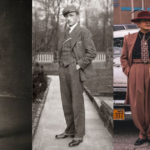Welcome to the Roaring Twenties, where we’re about to take you on a time-travelling journey into the fascinating world of 1920s women’s fashion pants in the USA, with a particular focus on pants. The 1920s were a transformative era in fashion history, marked by daring innovations and a spirit of rebellion that still resonates today.
When you think of the 1920s, it’s hard not to conjure up images of flappers – those daring, free-spirited young women who danced to the rhythm of jazz, sipped on illegal cocktails, and challenged societal norms with their sense of style. These women embodied the very essence of the era – a time of liberation, self-expression, and social upheaval.
The Birth of Flapper Culture
The 1920s marked a dramatic shift in societal norms in the USA, largely due to the aftermath of World War I and women’s suffrage. Young women were no longer content with the restrictive and modest clothing of the past. They craved freedom and independence. The flapper lifestyle was all about embracing these desires.
Flappers in the USA were rebels with a cause, and their fashion choices were a form of protest. They rejected the corsets and restrictive dresses that had characterised women’s fashion for decades. Instead, they opted for loose, drop-waist dresses and, most importantly, pants. These fashion choices were a direct challenge to societal norms, demonstrating that women could embrace comfort and mobility without sacrificing style.
The Transition from Skirts to Pants
Before the 1920s women’s fashion pants was characterised by long, heavy skirts, and corsets that reshaped their bodies into the fashionable hourglass figure. The attire was elegant but incredibly restrictive, limiting women’s mobility and freedom. These garments symbolised the traditional roles women were expected to play in society.
Fashion was an emblem of conformity, and women were expected to adhere to rigid standards of modesty and decorum. But the winds of change were already stirring, and they would soon reshape the fashion landscape.
Adopting Pants as a Symbol of Liberation
As the 1920s dawned, women were no longer content with the constraints of the past. They saw an opportunity for change and seized it. One of the most emblematic symbols of this change was the adoption of pants. This bold choice represented liberation in every sense.
Pants were associated with men’s clothing, and wearing them was a direct challenge to societal norms. Women who donned trousers were seen as trailblazers, paving the way for a new era of gender equality and individual freedom. Pants provided women with newfound comfort and versatility, allowing them to engage in activities previously reserved for men, such as sports and outdoor work.
Types of 1920s Women’s FAshion Pants
The 1920s brought about a fashion revolution in women’s clothing, and the adoption of pants played a significant role in this transformation. Here, we’ll explore the various styles of 1920s women’s fashion pants and the materials, colours, and embellishments that defined this iconic era in fashion.
- The Knickerbocker Pants: These were wide-legged, loose-fitting pants that usually ended just below the knee. They were often paired with knee-high stockings and oxford shoes, creating a sporty and youthful look. Knickerbockers were particularly popular for outdoor activities like -and bicycling.
- Beach Pajamas: Imagine stylish, flowing pants paired with a matching tunic top – that’s the essence of beach pyjamas. These were ideal for beachside outings and leisurely strolls, featuring bold, geometric patterns and lightweight materials.
- Oxford Bags: These wide-legged, high-waisted trousers were often made of wool or tweed. They were beloved by both men and women for their comfortable fit and made a bold fashion statement. Oxford bags were often paired with crisp, white shirts and suspenders.
- Tuxedo Pants: For those special evenings out, women embraced tuxedo pants, often made of satin or silk. These pants exuded sophistication and were typically paired with elegant blouses and accessories.
- Harem Pants: Inspired by Middle Eastern fashion, harem pants featured a dropped crotch and a relaxed fit. They were often made of lightweight materials, providing comfort and a unique look.
Materials, Colors, and Embellishments
- Materials: The 1920s were all about comfort and freedom, so pants were made from lightweight materials like silk, crepe, and jersey. These fabrics allowed for ease of movement, which was a departure from the heavy, restrictive textiles of previous eras.
- Colours: The colour palette of 1920s women’s pants ranged from classic black to vibrant pastels and bold patterns. Neutral tones were popular, but flappers were fearless in embracing striking hues, especially for beach pyjamas.
- Embellishments: Beads, sequins, and intricate embroidery were common embellishments on 1920s pants, especially for evening wear. These added a touch of glamour and reflected the overall extravagance of the era. Fringes, which swayed and sparkled with movement, were also a hallmark of 1920s fashion.
Conclusion:
In the vivid tapestry of the 1920s women’s fashion pants, we’ve embarked on a journey through an era of radical transformation, where flappers redefined not just fashion but an entire way of life. From the birth of flapper culture, their fearless attitude towards societal norms, to the groundbreaking transition from skirts to pants, we’ve uncovered the rebellious spirit that shaped this iconic period. The 1920s presented a diverse array of pants, each style mirroring the dynamism of the age, along with materials, colours, and embellishments that celebrated comfort and individuality.











